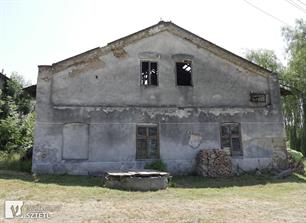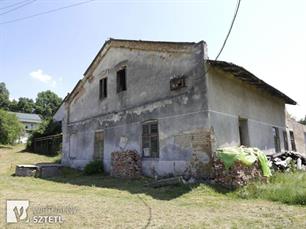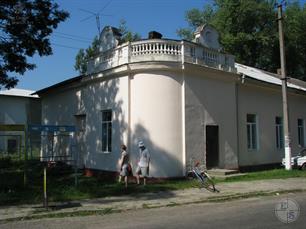Bukachivtsi
Ivano-Frankivsk district, Ivano-Frankivsk region
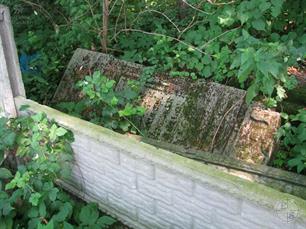 |
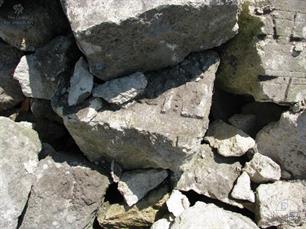 |
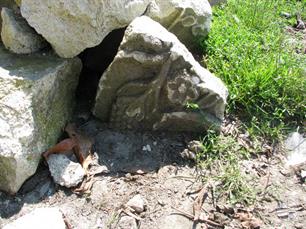 |
| Jewish cemetery in Bukachivtsi, 2010 | Tombstones from cemetery were used as building material in the neighboring village Bukachivska Sloboda |
Year - Total Population - Jews
1765 - [?] - 289
1859 - 1,840 - 1,059
1800 - 2,085 - 1,115
1900 - 2,459 - 1,216
1921 - 2,251 - 649
1765 - [?] - 289
1859 - 1,840 - 1,059
1800 - 2,085 - 1,115
1900 - 2,459 - 1,216
1921 - 2,251 - 649
Sources:
- Pinkas Hakehillot Polin: Encyclopedia of Jewish Communities, Poland, Volume II, page 89, published by Yad Vashem, Jerusalem. Translated by JewishGen, Inc.
Photo:
- Wirtualny sztetl. Bukaczowce
- Vladimir Levin, Jewish Galicia and Bukovina N.P.O. Published by Center for Jewish art
- Pinkas Hakehillot Polin: Encyclopedia of Jewish Communities, Poland, Volume II, page 89, published by Yad Vashem, Jerusalem. Translated by JewishGen, Inc.
Photo:
- Wirtualny sztetl. Bukaczowce
- Vladimir Levin, Jewish Galicia and Bukovina N.P.O. Published by Center for Jewish art
As a community, Bukaczowce (ukr. Bukachivtsi, Букачівці) has been mentioned in documents since 1438. In 1498 it received the status of a city under private noble ownership. Towards the end of the 18th and the beginning of the 19th century, Bukaczowce developed as the urban center for the surrounding agricultural areas.
In the 1870s the railroad line was extended to Bukaczowce.
During World War I Bukaczowce was damaged and partly destroyed by the Russian conquerors and mainly in 1920 by the marauding Petlura gangs.
Permanent Jewish settlement apparently developed in the 18th century; by mid century there was an organized community and in 1765 there were six villages numbering 52 individuals in Bukaczowce's jurisdiction.
In the 19th century the Jewish community grew and by the end of the century the population reached its peak.
During World War I Bukaczowce suffered under the Russian occupation, but the community suffered the most hardship in 1920, when the Polish armies retreated under the pressure of the Red Army. Shortly before the Bolsheviks entered Bukaczowce the Petlura gangs invaded and perpetrated a vicious pogrom for nearly 24 hours. A number of Jews were murdered and many women were brutally raped. The rabbi was severely beaten when he refused to reveal his daughter's hiding place.
The local Polish citizens hid many Jewish girls and women who ran to them for shelter before the pursuing mob.
On August 15, 1920, Red Army soldiers came into town and routed the Petlura gangs, but the new conquerors caused hardships as well. A heavy "contribution" was levied on the citizens of Bukaczowce and four hostages were taken, all of them Jews. Because of the events of the war the Jewish population of Bukaczowce dwindled to about half of what it had been in 1913; the Joint [Distribution Committee] came to their aid and with their help a number of families reestablished themselves, but the community never regained its strength.
In the 18th century the Jews of Bukaczowce either leased land, or were innkeepers or tradesmen.
In the 19th and 20th centuries there were more craftsmen in various fields; a number of Jews were farmers, but the vast majority made their livings in small businesses and by peddling in nearby villages.
In the second half of the 18th century the community had its own organized institutions and its own rabbi. The head of the rabbinate was then Rabbi Moshe Zvi Heller (died in 1770), known as the "Gaon Zvi".
In the 1830s the head of the Rabbinate in Bukaczowce was Rabbi Binyamin bar Simcha-Natan Ellenberg, who later moved to Lvov where he died in 1855. Rabbi Shlomo bar Moshe-David Ashkenazi replaced him, but in 1843 he left for Hungary and ten years later immigrated to Eretz Yisrael. His son, Rabbi Yoel Yitzhak, took his place (died in Kolomyya in 1867). For many years, from the end of the 19th century until 1929, Rabbi Ephraim-Segal Chamides was the town's rabbi, and after him Rabbi Zvi Schwartz, the last of Bukaczowce's rabbis.
By the beginning of the 20th century a Zionist organization and supplementary Hebrew school were established. Zionist activity began anew towards the end of World War I and in 1917 there was reported to be a branch of Poalei Zion there.
Branches of the General Zionists, Hitachdut and Revisionists, as well as the youth groups Zionist Youth, Beitar and Hashachar, were all active between the wars, though not all of them continuously. These organizations had libraries and conducted various amateur activities.
In 1923 a Hebrew School of the "Tarbut" chain was established. Cultural activities centered around the "HaZfira" Society and there was a library and a reading room.
In the 1933 Zionist Congress elections, the votes divided up as follows: General Zionists – 46; Mizrachi – 18; Hitachdut Poalei Zion – 14; Revisionists – 83. And in the 1935 elections: General Zionists -- 58; Mizrachi – 79; and Eretz Yisrael Ovedet – 130.
In the 1870s the railroad line was extended to Bukaczowce.
During World War I Bukaczowce was damaged and partly destroyed by the Russian conquerors and mainly in 1920 by the marauding Petlura gangs.
Permanent Jewish settlement apparently developed in the 18th century; by mid century there was an organized community and in 1765 there were six villages numbering 52 individuals in Bukaczowce's jurisdiction.
In the 19th century the Jewish community grew and by the end of the century the population reached its peak.
During World War I Bukaczowce suffered under the Russian occupation, but the community suffered the most hardship in 1920, when the Polish armies retreated under the pressure of the Red Army. Shortly before the Bolsheviks entered Bukaczowce the Petlura gangs invaded and perpetrated a vicious pogrom for nearly 24 hours. A number of Jews were murdered and many women were brutally raped. The rabbi was severely beaten when he refused to reveal his daughter's hiding place.
The local Polish citizens hid many Jewish girls and women who ran to them for shelter before the pursuing mob.
On August 15, 1920, Red Army soldiers came into town and routed the Petlura gangs, but the new conquerors caused hardships as well. A heavy "contribution" was levied on the citizens of Bukaczowce and four hostages were taken, all of them Jews. Because of the events of the war the Jewish population of Bukaczowce dwindled to about half of what it had been in 1913; the Joint [Distribution Committee] came to their aid and with their help a number of families reestablished themselves, but the community never regained its strength.
In the 18th century the Jews of Bukaczowce either leased land, or were innkeepers or tradesmen.
In the 19th and 20th centuries there were more craftsmen in various fields; a number of Jews were farmers, but the vast majority made their livings in small businesses and by peddling in nearby villages.
In the second half of the 18th century the community had its own organized institutions and its own rabbi. The head of the rabbinate was then Rabbi Moshe Zvi Heller (died in 1770), known as the "Gaon Zvi".
In the 1830s the head of the Rabbinate in Bukaczowce was Rabbi Binyamin bar Simcha-Natan Ellenberg, who later moved to Lvov where he died in 1855. Rabbi Shlomo bar Moshe-David Ashkenazi replaced him, but in 1843 he left for Hungary and ten years later immigrated to Eretz Yisrael. His son, Rabbi Yoel Yitzhak, took his place (died in Kolomyya in 1867). For many years, from the end of the 19th century until 1929, Rabbi Ephraim-Segal Chamides was the town's rabbi, and after him Rabbi Zvi Schwartz, the last of Bukaczowce's rabbis.
By the beginning of the 20th century a Zionist organization and supplementary Hebrew school were established. Zionist activity began anew towards the end of World War I and in 1917 there was reported to be a branch of Poalei Zion there.
Branches of the General Zionists, Hitachdut and Revisionists, as well as the youth groups Zionist Youth, Beitar and Hashachar, were all active between the wars, though not all of them continuously. These organizations had libraries and conducted various amateur activities.
In 1923 a Hebrew School of the "Tarbut" chain was established. Cultural activities centered around the "HaZfira" Society and there was a library and a reading room.
In the 1933 Zionist Congress elections, the votes divided up as follows: General Zionists – 46; Mizrachi – 18; Hitachdut Poalei Zion – 14; Revisionists – 83. And in the 1935 elections: General Zionists -- 58; Mizrachi – 79; and Eretz Yisrael Ovedet – 130.
We do not know what happened in Bukaczowce during the Soviet period, but it can be assumed that it was typical for that regime. After the German invasion of the USSR, a number of Jews from Bukaczowce joined the Red Army and escaped to the east.
The Germans entered Bukaczowce on July 3, 1941, and soon enforced edicts against the Jews: a 7 p.m. curfew and the yellow star. In the area Ukrainians robbed and murdered the villages' Jews, but in Bukaczowce itself there were no pogroms.
Ukrainian police kidnapped Jews for hard labor and beat and degraded them. Gold, silver and jewelry were confiscated from the Jews. In order to insure compliance, prominent Jewish citizens were taken hostage. The Judenrat was formed in the summer of 1941, and Emil Kroiz was appointed chairman.
A Jewish police force was formed as well. The first duties of the Judenrat included involvement in the confiscation of valuables and the formation of Jewish work forces.
In the winter of 1941-1942 the Jews were ordered to hand over all fur products in their possession to the authorities; evaders faced the death penalty. For those with means it was not difficult to find food; they sold their possessions and bought food from the farmers in the area. The poorer Jews worked on the farms and in this way procured food for themselves and their families.
A number of Jews were employed in service jobs and others in the professions by the local authorities and received small salaries and some food. Thus the Jews of Bukaczowce did not suffer starvation.
In the spring of 1942 Jews from surrounding small towns began to be concentrated in Bukaczowce. In April the Jews of Knihynicze were brought in.
The population of Bukaczowce grew by several hundred. The additional population caused crowding in housing, a worsening of sanitary conditions and cases of typhus appeared. The refugees and apparently some of the local Jews, men and women 15 and over were forced to work on the neighboring farm. The laborers were given only small amounts of food, but were able to get additional food.
Reports of extermination "aktias" in Bukaczowce contradict one another. We can assume that the first "aktia" was on September 21, 1942, the second on October 26, 1942, and the last in January 1943. On September 21, 1942 (Yom Kippur 5703), a police unit arrived from Rohatyn and together with the Ukrainian and the Jewish policemen, went from house to house, forced the Jews outside (many were praying in minyans at the time) and concentrated them in the building next to the Judenrat.
A number of people escaped to the nearby forests or found hiding places in the town. The Germans shot at those trying to escape and several tens of Jews were killed. At the gathering center the Germans selected 100-300 people, mostly the old, sick or weak. That night they were led to the train station and sent to Rohatyn where an "aktia" was also taking place, and from there they were sent to the Belzec extermination camp. The following day all the Bukaczowce workers went to work as usual.
On October 15, 1942, a group of apparently several hundred Jews were brought to Bukaczowce from Bursztyn. After a number of days, on October 26, the second transport "aktia" was carried out. This time the Gestapo and the Ukrainian police closed off the exits from the town. Again they went from house to house and concentrated the Jews in the market square. From there they were taken to the train station and sent to Belzec.
The number of victims of this "aktia" was greater than the previous "aktia" and included all the refugees from Bursztyn. All the Jews remaining in Bukaczowce were those who had successfully hidden, the Judenrat and the Jewish policemen.
Bukaczowce was one of the places declared a ghetto by the Galician District Nazi Headquarters on December 1, 1942, with the intention of interning all the remaining Jews in the area. However in the end the central ghetto was formed in Kozova and not Bukaczowce.
The Jewish community was finally liquidated in January 1943. The Jews were ordered to go to Rohatyn within three days. The deportees were allowed to take some of their possessions with them but in Rohatyn they met the same fate as the local Jews.
The Soviet army liberated Bukaczowce on July 27, 1944. Only about 20 Jews from Bukaczowce and the surrounding towns survived, those who hid in the woods, those who found shelter with Christian neighbors, and those who had false papers. A good number of Bukaczowce's Jews survived by escaping to the Soviet Union.
The Germans entered Bukaczowce on July 3, 1941, and soon enforced edicts against the Jews: a 7 p.m. curfew and the yellow star. In the area Ukrainians robbed and murdered the villages' Jews, but in Bukaczowce itself there were no pogroms.
Ukrainian police kidnapped Jews for hard labor and beat and degraded them. Gold, silver and jewelry were confiscated from the Jews. In order to insure compliance, prominent Jewish citizens were taken hostage. The Judenrat was formed in the summer of 1941, and Emil Kroiz was appointed chairman.
A Jewish police force was formed as well. The first duties of the Judenrat included involvement in the confiscation of valuables and the formation of Jewish work forces.
In the winter of 1941-1942 the Jews were ordered to hand over all fur products in their possession to the authorities; evaders faced the death penalty. For those with means it was not difficult to find food; they sold their possessions and bought food from the farmers in the area. The poorer Jews worked on the farms and in this way procured food for themselves and their families.
A number of Jews were employed in service jobs and others in the professions by the local authorities and received small salaries and some food. Thus the Jews of Bukaczowce did not suffer starvation.
In the spring of 1942 Jews from surrounding small towns began to be concentrated in Bukaczowce. In April the Jews of Knihynicze were brought in.
The population of Bukaczowce grew by several hundred. The additional population caused crowding in housing, a worsening of sanitary conditions and cases of typhus appeared. The refugees and apparently some of the local Jews, men and women 15 and over were forced to work on the neighboring farm. The laborers were given only small amounts of food, but were able to get additional food.
Reports of extermination "aktias" in Bukaczowce contradict one another. We can assume that the first "aktia" was on September 21, 1942, the second on October 26, 1942, and the last in January 1943. On September 21, 1942 (Yom Kippur 5703), a police unit arrived from Rohatyn and together with the Ukrainian and the Jewish policemen, went from house to house, forced the Jews outside (many were praying in minyans at the time) and concentrated them in the building next to the Judenrat.
A number of people escaped to the nearby forests or found hiding places in the town. The Germans shot at those trying to escape and several tens of Jews were killed. At the gathering center the Germans selected 100-300 people, mostly the old, sick or weak. That night they were led to the train station and sent to Rohatyn where an "aktia" was also taking place, and from there they were sent to the Belzec extermination camp. The following day all the Bukaczowce workers went to work as usual.
On October 15, 1942, a group of apparently several hundred Jews were brought to Bukaczowce from Bursztyn. After a number of days, on October 26, the second transport "aktia" was carried out. This time the Gestapo and the Ukrainian police closed off the exits from the town. Again they went from house to house and concentrated the Jews in the market square. From there they were taken to the train station and sent to Belzec.
The number of victims of this "aktia" was greater than the previous "aktia" and included all the refugees from Bursztyn. All the Jews remaining in Bukaczowce were those who had successfully hidden, the Judenrat and the Jewish policemen.
Bukaczowce was one of the places declared a ghetto by the Galician District Nazi Headquarters on December 1, 1942, with the intention of interning all the remaining Jews in the area. However in the end the central ghetto was formed in Kozova and not Bukaczowce.
The Jewish community was finally liquidated in January 1943. The Jews were ordered to go to Rohatyn within three days. The deportees were allowed to take some of their possessions with them but in Rohatyn they met the same fate as the local Jews.
The Soviet army liberated Bukaczowce on July 27, 1944. Only about 20 Jews from Bukaczowce and the surrounding towns survived, those who hid in the woods, those who found shelter with Christian neighbors, and those who had false papers. A good number of Bukaczowce's Jews survived by escaping to the Soviet Union.

- Home
- Shtetls
- Vinnytsia region
- Volyn region
- Dnipro region
- Donetsk region
- Zhytomyr region
- Zakarpattia region
- Zaporizhzhia region
- Ivano-Frankivsk region
- Kyiv region
- Kropyvnytskyi region
- Luhansk region
- Lviv region
- Mykolayiv region
- Odessa region
- Poltava region
- Rivne region
- Sumy region
- Ternopil region
- Kharkiv region
- Kherson region
- Khmelnytskyi region
- Chernihiv region
- Chernivtsi region
- Cherkasy region
- Crimea
- Synagogues
- Cemeteries
- Objects & guides
- Old photos
- History
- Contact
Jewish towns of Ukraine
Jewish towns of Ukraine
My shtetl
My shtetl
Donate
